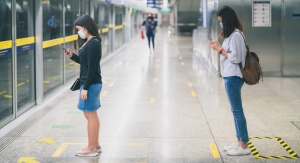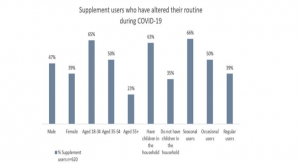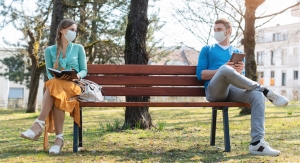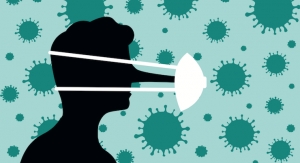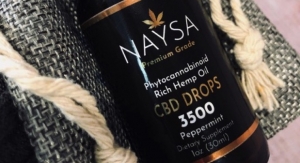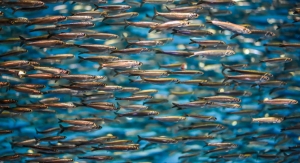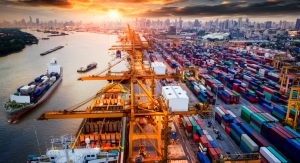By Sean Moloughney, Editor, Nutraceuticals World03.05.20
Fears about a global pandemic are spreading as COVID-19, the respiratory disease caused by a novel coronavirus which originated in Wuhan, the capital of China’s Hubei province, has now reached at least 97 countries, sickening over 110,000 people. More than 4,000 people have died—the vast majority in mainland China.
Alongside the devastating loss of human life, the global economy has fallen victim to the crisis as well, as financial markets have been volatile in recent weeks. Some economists have predicted a slide into recession if the disease can’t be contained or managed effectively. There is still no vaccine but health researchers are ramping up that effort.
Major business events have been effected around the world. Natural Products Expo West—billed as the largest natural products event in the world—was postponed due to concerns about COVID-19. The event was expected to gather nearly 90,000 people on Anaheim’s Convention Center campus.
Companies have been taking varied approaches about limiting or restricting travel. NOW Health Group, for example, has limited travel generally, and employees who travel internationally are required to work from home for two weeks after they return.
Others said they have been following government guidance and not placed restrictions on conducting business unless otherwise directed.
To date, the Centers for Disease Control has issued Level 3 Travel Health Notices for China, Iran, South Korea, and Italy; and a Level 2 notice for Japan.
Lockdown
News about the virus emerged just as China’s busiest travel season was beginning, with over 600 million people traveling to their home towns to celebrate the Lunar New Year, one of the country’s biggest public holidays, during which basically everything shuts down for days.
“Many companies that do business with China are prepared for this annual holiday, and plan in advance,” noted Wilson Lau, vice president of Nuherbs, a major importer of botanicals from China.
But the epidemic has continued to spread, disrupting travel, supply chains, and logistics, and compelling China’s government to take drastic action.
“What is happening in China is truly unprecedented,” Loren Israelsen, president of the United Natural Products Alliance (UNPA), said during a Feb. 27 webinar hosted by TraceGains, a software company that delivers cloud-based supplier compliance and quality management solutions for the food, beverage, and supplement industries.
In a country of 1.3 billion people, there is virtually no movement in most parts of China, far beyond just Wuhan and Hubei province, Israelsen said. “As the coronavirus in Wuhan became far worse, and more serious, the government took the decision to lock the country down. But this meant 600 million people were locked down in the wrong place—not at home, not by their office, their jobs, or their factories.”
Logistics have essentially come to a grinding halt, he added. “This of course, as you know, is affecting the global markets, given China’s importance to global trade.”
Supply Disruption
The natural products industry is particularly dependent on China for raw materials. “Somewhere between 75 to 80% of all the natural product raw materials that we use in dietary supplements are sourced from China,” Israelsen estimated. “A lot—but we do not have a specific percent—are China sole-sourced ingredients. Certainly, some of the key amino acids and nutrients are nearly sole-sourced from China. And with the shutdown that has taken place, this is now affecting the availability of the normal flows of raw materials coming from China to the U.S. and the global markets.”
During its Feb. 27 webcast, TraceGains CEO Gary Nowacki noted some of the top food ingredients, additives and raw materials for supplements commonly sourced from China that could be impacted include: garlic products, potassium sorbate, apple juice concentrate, vitamin C (ascorbic acid), calcium, and sweeteners such as stevia, sucralose, acesulfame K, and aspartame, among many others.
Lau said Nuherb’s first priority is to make sure all its people are safe, and that the proper actions be taken to safeguard the general public. “In terms of our ability to supply material, in the short term our customers' needs will be met on a timely basis. We’re China experts, so we always plan in advance for the Chinese New Year shutdown. We had material landed right before the New Year so we have enough stock on hand. We made commitments to farmers last fall to acquire herbs that meet our standards, and this material was processed to our specs immediately after harvest.”
Material has been ready and could begin shipping this week or next despite logistical challenges, he added.
Generally speaking, Lau suggested companies contact their suppliers and work with them proactively to ensure continuous supply. “Help the uncertain situation by providing your suppliers with as much certainty as possible.”
Steve Mister, president and CEO of the Council for Responsible Nutrition (CRN), said the trade group is “very concerned” about potential supply chain disruptions as factories may not be operating at full capacity, or at all, depending on the health of workers.
“It’s too soon to know what the long-term impact will be but we’re preparing our companies that there are potential impacts for this,” he said. “We’ve been advising our members that they always need to have a plan B in place. Before there was coronavirus we had the tariffs this past fall. I think responsible companies are always evaluating their supply chains, whether it’s because of economic issues like tariffs or physical ones like coronavirus and you just can’t get the material.”
Israelsen also noted that companies are evaluating their sourcing relationships with China, particularly for critical or sole-sourced supplies.
“We’re beginning to see criticality in FSMA (Food Safety Modernization Act) compliance, specifically foreign supplier verification.” With a “tremendous scramble” to find new and secondary suppliers, under FSMA requirements, companies still need to know the original supplier of goods.
“This has scrambled the deck for many of us and will continue to be an ongoing problem,” Israelsen said. “This is compounded by the number of 'ghost factories' in China—meaning the factory that you think is producing your product very often has a subcontract with another factory that you don’t know about—hence the ghost factory. The product you receive comes from your contracted supplier, but very often there are multiple other ghost factories that they will trade work with. It’s going to become increasingly difficult to be assured of the source of supply.”
The big question on everyone’s mind is how deep are the supply reserves in China, and how deep are they in the U.S. and elsewhere?
India is emerging as a “strong second source of supply,” according to Israelsen. “There is also growing talk about reestablishing primary U.S. source of supply. I think this is an appropriate discussion in order to reestablish domestic capacity to produce a great number of nutrients as well as amino acids and other sources. This supply chain is so vast; with food ingredients, additives, nutrients that go into such a broad range of products, this is now becoming an incredibly important issue.”
Israelsen suggested the old procurement system of global travel to far countries of the world that relied on building personal relationships and networks to establish primary sourcing partnerships may be just that—an old system.
“COVID-19 brings into very sharp relief the opportunity to go into the new world systems that are based on digital networks, big data collection, understanding the geolocation of where the goods are, and having live-time-insight about how do we find, first, primary goods, and if backup is necessary where do we go to find that?”
COVID-19 is presenting “a stress test moment” that will compel companies to evaluate their supply chains and adapt into new systems, Israelsen added. “And we should do that on a very rapid basis on the view that we need to do this, whether it’s COVID-19 or not.”
Logistics
Lau said factories in China are starting to get back up and running, but nowhere near usual capacity, as people are still coming out of quarantine, and not traveling.
“During the quarantine, cargo ships and flights were cancelled, so everything was at a standstill. About 80% of the world’s goods are carried by sea, and seven of the 10 world’s busiest container ports are in China,” Lau noted. “Cargo ships and air freight have resumed but are nowhere near usual levels. Air shipment isn’t viable for large quantities, but it’s a short-term solution, and far more expensive—approximately 10-15 cents a kilo for container sea freight vs. $4-9 per kilo air shipment. It’s made more daunting by the tariffs, which are still 25% on dried herbs, and even with items that were being tariffed at 15% now rolled back to 7%.”
Most of the industry in the U.S. wasn’t very concerned about disruption due to the coronavirus until recently, Lau added. “In the week leading up to Expo West’s scheduled start date discussion about whether or not the show should be cancelled really brought this issue to the forefront.”
Since the event was postponed, Lau said he’s getting more inquiries about access to material. “People are really worried now that Expo is no longer the focus and they have the bandwidth to think about it and deal with it.”
Overall, Israelsen said there’s a “significant logistics problem,” as many ships and containers are out of rotation. When things begin to ramp up, high-value cargo will go first. “Parts that go into iPhones and automobiles, they will get the first containers. Our products will be relatively low on the priority list leaving China.”
Even when conditions improve in China, he said to expect a lag time on logistics, “probably as much as 60 days, possibly longer, in terms of just being able to book container space.” China domestic consumption will also come first before they begin further exports, he noted.
Given all the steps in the process, being able to get certain products from China on the water, shipped, cleared by customs, and delivered, “I think you should consider the likelihood of extended delays through mid-year, if not later,” Israelsen said.
Meanwhile, an important and unanticipated issue could be a shortage of protective gear for workers at U.S. manufacturing plants. 3M has reportedly increased production of N95 filter face masks, but priority will be given to patients, healthcare providers, and military.
“What do you do if normal supplies of protective gear aren’t available,” said Israelsen. “I don’t have a good answer. No one anticipated this problem.”
Alongside the devastating loss of human life, the global economy has fallen victim to the crisis as well, as financial markets have been volatile in recent weeks. Some economists have predicted a slide into recession if the disease can’t be contained or managed effectively. There is still no vaccine but health researchers are ramping up that effort.
Major business events have been effected around the world. Natural Products Expo West—billed as the largest natural products event in the world—was postponed due to concerns about COVID-19. The event was expected to gather nearly 90,000 people on Anaheim’s Convention Center campus.
Companies have been taking varied approaches about limiting or restricting travel. NOW Health Group, for example, has limited travel generally, and employees who travel internationally are required to work from home for two weeks after they return.
Others said they have been following government guidance and not placed restrictions on conducting business unless otherwise directed.
To date, the Centers for Disease Control has issued Level 3 Travel Health Notices for China, Iran, South Korea, and Italy; and a Level 2 notice for Japan.
Lockdown
News about the virus emerged just as China’s busiest travel season was beginning, with over 600 million people traveling to their home towns to celebrate the Lunar New Year, one of the country’s biggest public holidays, during which basically everything shuts down for days.
“Many companies that do business with China are prepared for this annual holiday, and plan in advance,” noted Wilson Lau, vice president of Nuherbs, a major importer of botanicals from China.
But the epidemic has continued to spread, disrupting travel, supply chains, and logistics, and compelling China’s government to take drastic action.
“What is happening in China is truly unprecedented,” Loren Israelsen, president of the United Natural Products Alliance (UNPA), said during a Feb. 27 webinar hosted by TraceGains, a software company that delivers cloud-based supplier compliance and quality management solutions for the food, beverage, and supplement industries.
In a country of 1.3 billion people, there is virtually no movement in most parts of China, far beyond just Wuhan and Hubei province, Israelsen said. “As the coronavirus in Wuhan became far worse, and more serious, the government took the decision to lock the country down. But this meant 600 million people were locked down in the wrong place—not at home, not by their office, their jobs, or their factories.”
Logistics have essentially come to a grinding halt, he added. “This of course, as you know, is affecting the global markets, given China’s importance to global trade.”
Supply Disruption
The natural products industry is particularly dependent on China for raw materials. “Somewhere between 75 to 80% of all the natural product raw materials that we use in dietary supplements are sourced from China,” Israelsen estimated. “A lot—but we do not have a specific percent—are China sole-sourced ingredients. Certainly, some of the key amino acids and nutrients are nearly sole-sourced from China. And with the shutdown that has taken place, this is now affecting the availability of the normal flows of raw materials coming from China to the U.S. and the global markets.”
During its Feb. 27 webcast, TraceGains CEO Gary Nowacki noted some of the top food ingredients, additives and raw materials for supplements commonly sourced from China that could be impacted include: garlic products, potassium sorbate, apple juice concentrate, vitamin C (ascorbic acid), calcium, and sweeteners such as stevia, sucralose, acesulfame K, and aspartame, among many others.
Lau said Nuherb’s first priority is to make sure all its people are safe, and that the proper actions be taken to safeguard the general public. “In terms of our ability to supply material, in the short term our customers' needs will be met on a timely basis. We’re China experts, so we always plan in advance for the Chinese New Year shutdown. We had material landed right before the New Year so we have enough stock on hand. We made commitments to farmers last fall to acquire herbs that meet our standards, and this material was processed to our specs immediately after harvest.”
Material has been ready and could begin shipping this week or next despite logistical challenges, he added.
Generally speaking, Lau suggested companies contact their suppliers and work with them proactively to ensure continuous supply. “Help the uncertain situation by providing your suppliers with as much certainty as possible.”
Steve Mister, president and CEO of the Council for Responsible Nutrition (CRN), said the trade group is “very concerned” about potential supply chain disruptions as factories may not be operating at full capacity, or at all, depending on the health of workers.
“It’s too soon to know what the long-term impact will be but we’re preparing our companies that there are potential impacts for this,” he said. “We’ve been advising our members that they always need to have a plan B in place. Before there was coronavirus we had the tariffs this past fall. I think responsible companies are always evaluating their supply chains, whether it’s because of economic issues like tariffs or physical ones like coronavirus and you just can’t get the material.”
Israelsen also noted that companies are evaluating their sourcing relationships with China, particularly for critical or sole-sourced supplies.
“We’re beginning to see criticality in FSMA (Food Safety Modernization Act) compliance, specifically foreign supplier verification.” With a “tremendous scramble” to find new and secondary suppliers, under FSMA requirements, companies still need to know the original supplier of goods.
“This has scrambled the deck for many of us and will continue to be an ongoing problem,” Israelsen said. “This is compounded by the number of 'ghost factories' in China—meaning the factory that you think is producing your product very often has a subcontract with another factory that you don’t know about—hence the ghost factory. The product you receive comes from your contracted supplier, but very often there are multiple other ghost factories that they will trade work with. It’s going to become increasingly difficult to be assured of the source of supply.”
The big question on everyone’s mind is how deep are the supply reserves in China, and how deep are they in the U.S. and elsewhere?
India is emerging as a “strong second source of supply,” according to Israelsen. “There is also growing talk about reestablishing primary U.S. source of supply. I think this is an appropriate discussion in order to reestablish domestic capacity to produce a great number of nutrients as well as amino acids and other sources. This supply chain is so vast; with food ingredients, additives, nutrients that go into such a broad range of products, this is now becoming an incredibly important issue.”
Israelsen suggested the old procurement system of global travel to far countries of the world that relied on building personal relationships and networks to establish primary sourcing partnerships may be just that—an old system.
“COVID-19 brings into very sharp relief the opportunity to go into the new world systems that are based on digital networks, big data collection, understanding the geolocation of where the goods are, and having live-time-insight about how do we find, first, primary goods, and if backup is necessary where do we go to find that?”
COVID-19 is presenting “a stress test moment” that will compel companies to evaluate their supply chains and adapt into new systems, Israelsen added. “And we should do that on a very rapid basis on the view that we need to do this, whether it’s COVID-19 or not.”
Logistics
Lau said factories in China are starting to get back up and running, but nowhere near usual capacity, as people are still coming out of quarantine, and not traveling.
“During the quarantine, cargo ships and flights were cancelled, so everything was at a standstill. About 80% of the world’s goods are carried by sea, and seven of the 10 world’s busiest container ports are in China,” Lau noted. “Cargo ships and air freight have resumed but are nowhere near usual levels. Air shipment isn’t viable for large quantities, but it’s a short-term solution, and far more expensive—approximately 10-15 cents a kilo for container sea freight vs. $4-9 per kilo air shipment. It’s made more daunting by the tariffs, which are still 25% on dried herbs, and even with items that were being tariffed at 15% now rolled back to 7%.”
Most of the industry in the U.S. wasn’t very concerned about disruption due to the coronavirus until recently, Lau added. “In the week leading up to Expo West’s scheduled start date discussion about whether or not the show should be cancelled really brought this issue to the forefront.”
Since the event was postponed, Lau said he’s getting more inquiries about access to material. “People are really worried now that Expo is no longer the focus and they have the bandwidth to think about it and deal with it.”
Overall, Israelsen said there’s a “significant logistics problem,” as many ships and containers are out of rotation. When things begin to ramp up, high-value cargo will go first. “Parts that go into iPhones and automobiles, they will get the first containers. Our products will be relatively low on the priority list leaving China.”
Even when conditions improve in China, he said to expect a lag time on logistics, “probably as much as 60 days, possibly longer, in terms of just being able to book container space.” China domestic consumption will also come first before they begin further exports, he noted.
Given all the steps in the process, being able to get certain products from China on the water, shipped, cleared by customs, and delivered, “I think you should consider the likelihood of extended delays through mid-year, if not later,” Israelsen said.
Meanwhile, an important and unanticipated issue could be a shortage of protective gear for workers at U.S. manufacturing plants. 3M has reportedly increased production of N95 filter face masks, but priority will be given to patients, healthcare providers, and military.
“What do you do if normal supplies of protective gear aren’t available,” said Israelsen. “I don’t have a good answer. No one anticipated this problem.”


